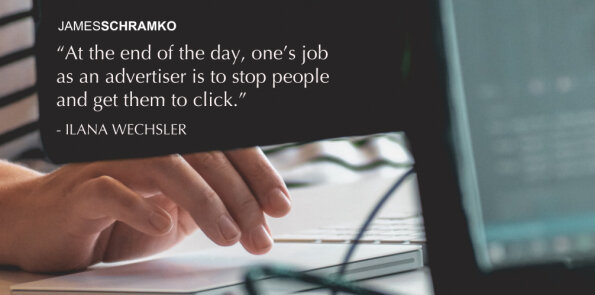Podcast: Download (Duration: 38:59 — 39.4MB)
Get Notified Of Future Episodes Apple Podcasts | Spotify | Amazon Music | Android | Blubrry | Gaana | TuneIn | Deezer | Anghami | RSS | More
In this episode:
What can Ilana Wechsler offer that courses and agencies can’t? [02:43]
With all the people Ilana helps with traffic, these are the areas she’s seen them get stuck… [06:35]
People ask a lot of questions concerning paid traffic – here are some of them. [08:25]
When you have the capacity to understand numbers and to communicate, these are the sort of things you may wind up talking about. [11:29]
Stuff can go wrong with new ad accounts – Ilana talks about the fixes. [14:25]
Ever hear of UTM parameters? You probably have and don’t realize how powerful they are. [20:20]
Different traffic objectives require different kinds of campaign treatment. [23:28]
What creatives do and don’t work? [26:30]
When you’ve put in the effort and the conversions don’t materialize… [31:10]
Ilana discusses how to avoid one of her pet hates. [34:39]
Step up your marketing with James’s help
 Traffic expert Ilana Wechsler is in demand these days. Because traffic is a constant topic, says James. It just doesn’t go away. If you have a business online, at some point, you’re going to want to get people to it.
Traffic expert Ilana Wechsler is in demand these days. Because traffic is a constant topic, says James. It just doesn’t go away. If you have a business online, at some point, you’re going to want to get people to it.
James often gets asked what the best traffic course is, or whose is the best agency people can approach. And typically, these people have already tried something that didn’t work.
He figures there must be some middle ground between learning from content and being coached, and he believes Ilana provides that.
Beyond courses and agencies
So what has Ilana seen as an educator, helping people with their traffic problems? What does she offer that’s different from a Facebook advertising course or an agency?
Ilana herself consumes a lot of courses. And it’s one thing to buy a course, she says – it’s another to make the logical leap of, this is how it applies to my business. Bridging that gap is the challenge.
And the ability to say to someone: I did what you said, and this is what I found. Have I done something wrong, is this right? That, says Ilana, is priceless. It’s very, very normal to hit roadblocks, and it’s so important to be able to get feedback.
The places people typically get stuck
So where do people normally get stuck? Are there common themes or patterns, asks James? Is there an area Ilana sees that’s especially valuable to someone entering her ecosystem?
Yeah, the starting point for those just getting their toes wet is often joining her 14-day retargeting challenge. This is at teachtraffic.com/challenge, and sells for a $10 one-off fee. In it, Ilana breaks down how to create a retargeting campaign on both Facebook and Google. The daily content is bite-sized – one to three videos to consume.
Most people making the transition from starting traffic or having an agency to bringing things in-house are looking for more control, faster response times. Because launching a campaign with an agency can take sometimes a week, and they want to be more nimble.
Integrate with their tech stack team, their content team, says James.
That, and integrate with their email marketing as well, Ilana says. Some people want to run a promo via email, but they want their Google or Facebook retargeting ads to coincide with the emails.
What kinds of questions does Ilana address?
Ilana’s retargeting challenge is how most people start to roll up their sleeves and get experience. And Ilana helps by answering a lot of their questions.
Hang on, says James. For $10, she’s answering questions?
Yup, says Ilana. As long as they’ve got questions regarding retargeting. Full disclosure, her goal is to provide them with a huge amount of value so they like what they see and decide to upgrade to the full membership. But they don’t have to. It’s a one-off course.
If they do it right, James imagines it would pay for the membership anyway. What questions do they have?
So many, Ilana says. She could rattle off a couple.
Generally, questions on retargeting are broken down into four distinct areas. The first, getting their tech set up, trips up a lot of people. It’s a bit fiddly to get the ducks in a row, data talking nicely to each other, the right codes on the right pages and so forth.
Second is around the offer that they’re showing their retargeting audience. Third is what creative to use.
 Fourth is understanding the data once the campaign is running. People want to know if their numbers are good, and that’s hard for them to know in isolation. Often, says Ilana, people don’t realize if they’re doing really well. And conversely, they don’t realize if their ad’s completely tanking.
Fourth is understanding the data once the campaign is running. People want to know if their numbers are good, and that’s hard for them to know in isolation. Often, says Ilana, people don’t realize if they’re doing really well. And conversely, they don’t realize if their ad’s completely tanking.
For $10, says James, if they ask the questions, get set up with a working offer and creatives, and get the data, they’ll know if their product’s good or not.
Yes, Ilana says, and they’ve got access to the videos afterwards. No hidden catches, whatsoever. As she said, her ultimate goal is to make it insane value for people. She may one day increase the price.
The things a former data analyst can talk about
Now Ilana has the incredible capacity to both understand numbers and communicate with people. So what sort of things does she talk about with them?
A really common question is when they install tracking codes on their website, create audiences in their Google and Facebook ad accounts, and start accumulating people. When they check their Google Analytics account, they might see a lot more users than what the numbers show inside their ad account.
So say Google Analytics shows 1000 visitors in the last 30 days. You’d expect the same number in your Google Ad Account. But what happens, says Ilana, is it only starts recording people when you create your audience. It won’t back-populate.
That’s why it’s important, she says, in day one of the retargeting challenge, to get the host tracking codes on your website, so that it can start remembering who’s visited.
Another question people have is about what bid strategy they should use.
Google’s is essentially an auction system, isn’t it, asks James?
It is, Ilana says. But Google has made massive advancements the last couple of years towards what’s called machine learning and artificial intelligence, away from the advertiser doing manual bidding to Google taking care of the bidding itself. Often the default bid strategy is what’s called maximized conversions.
That is where you’re basically saying to Google, I don’t care what I pay for a click, just get me as many sales as possible. But it can often be unprofitable.
What could go wrong?
A lot could go wrong, especially with a brand new ad account, which has zero data.
There seems like some biases built in, says James. Like, if someone pays more, it could be in Google’s interest to earn more.
Absolutely, says Ilana. But the real problem is with a brand new ad account, Google doesn’t have any data to apply its machine learning. So it’s wild swings in cost per click.
So you need to train it. You need to give it instructions, James says.
Exactly. So often Ilana say to people, skip the default settings, and just do manual CPC starting out so you can control your costs, and hopefully get some good data in your account, and then possibly later migrate to machine learning.
Another setup question people have is, do they exclude mobile apps from their retargeting campaign? There are lots of junk placements out there that needs to be just excluded.
And on the Facebook side of things, a big setup question that people have is, off the back of Apple iOS 14 update, there’s a whole new method of creating conversion events. It’s all explained in a video, but you need to prioritize events now.
It’s a minefield, says James. No wonder Ilana needs to talk to them.
 It is a bit of a minefield, if you don’t have instruction, says Ilana. That is why the setup is so critical, because if you are running a campaign with bad data, you’re flying blind. So you have to get this stuff right first. And once you’ve set it up, you’re away even for cold traffic campaigns.
It is a bit of a minefield, if you don’t have instruction, says Ilana. That is why the setup is so critical, because if you are running a campaign with bad data, you’re flying blind. So you have to get this stuff right first. And once you’ve set it up, you’re away even for cold traffic campaigns.
Checking what Ilana calls the digital plumbing of people’s accounts is step one when they come on board her Teach Traffic membership. And very rarely does she find it hooked up correctly.
“There are good agencies and bad agencies. – James Schramko”
As someone who’s spent quite a lot of money on ads and as an agency, James says, there are good agencies and bad agencies. When you’re an agency, you’re a very good agency. He imagine Ilana has probably had to fix some other plumber’s work.
Absolutely, she says. They never, ever assume it’s been set up correctly.
UTM parameters explained
Now what is a UTM parameter, James asks? He knows what it is, but other people probably hear the term and don’t understand how powerful it is.
It’s a Google Analytics trackable link, says Ilana. And it enables you to really have control over your traffic sources.
The problem people have when running traffic is Facebook ad traffic is mixed in with their Facebook organic traffic, is mixed in with their Facebook referral traffic. When they log into their Analytics to see how their traffic sources are performing and converting, they can’t distinguish their Facebook ad traffic from their organic.
So if you create a trackable link, just for your Facebook ads, that will separate that Facebook ad traffic from the Facebook organic traffic.
And you can see lots of data – how many users clicked on it, how long they spent on your website, did they view more than one page? And ultimately, did they do what you wanted them to do, which is buy or contact you or whatever is your goal?
So Ilana is saying, use a Google Analytics tracking link with your Facebook campaigns, says James.
Correct, says Ilana. At the ad level.
The differences Ilana needs to accommodate
Now, James imagines, people going through the challenge might be coming from different sort of types of businesses – e-commerce, or info product, or an agency. They might have different objectives which will require some subtle discussions.
On the Facebook side of things, creating your Facebook retargeting campaign, Ilana’s personal preference is to always choose a conversion objective campaign, which is really your way of telling Facebook what your goal is. Some people create a video views campaign, which is telling Facebook, I just want people to watch my video.
Being a results-driven person, Ilana always likes to tell Facebook, I want people to watch my video, but I also want people to click and buy. Sometimes, though, they will choose a traffic campaign, if they’re just trying to get as many people as possible back to the offer.
What else does Ilana notice that’s different? Say, with the offer, there are so many possibilities, aren’t there?
So many, says Ilana. An one common question is, maybe you’re running cold traffic campaign to some kind of offer, say a book, and people come, but don’t buy. Do you show an ad for your book again? Or do you show something different?
“The answer is really to test. – Ilana Wechsler”
The answer is really to test. The question then becomes, how long do you test for?
So people say, Oh, here’s what I’ve got, and you know, what are my options here? And you can say, Well, you could try this, this and this. Go ahead and set them up, says James.
Exactly, Ilana says.
Questions around the creatives
A lot of people have questions about creative as well, like, what creative works? What creative doesn’t work? (Creative being the words and the pictures you show people.)
 At the end of the day, says Ilana, one’s job as an advertiser is to stop people and get them to click.
At the end of the day, says Ilana, one’s job as an advertiser is to stop people and get them to click.
Some people may not even have resource to do the words and the pictures, James says. Can everyone do this themselves?
Many people use Canva. Or they might hire someone to do some one-off banners, or they might create them themselves. And often really simple creative is actually really effective. It doesn’t need to be designed by a graphic designer.
Because they’re not just blending in, says James. They’re jarring, almost.
Or the copy is so good that it just stops people – they just stop and think about it, says Ilana.
What about the video side of things?
Ilana’s also been quite interested in videos, doing a lot of stuff with YouTube. And obviously Facebook allows you to load videos as well as images or just text. Does she want to speak to the video image side of things?
In terms of a video ad, Ilana always recommends people split test an image ad versus a video ad on Facebook. And this is really particularly relevant for people with e-commerce.
“Often, the best video ads for e-commerce are just really simple. – Ilana Wechsler”
Often, the best video ads for e-commerce are just really simple, maybe even face-to-camera explainer videos. People can usually see the product. What you’re trying to do is simulate the experience people might have if they walked into the store and picked up the product and held it and touched it and opened it. A video ad that goes through that is often very, very effective.
When the conversions just aren’t happening
Now what if, after going through a course, spending the money, hiring people, putting together their offer and running a launch, someone makes no sales or very few sales? Where do you go from there?
It’s a tough one, says Ilana. And her heart breaks for these people. We’ve all been there, she says. The stuff they do is not easy, but it rewards the persistent. And she always says to people, success with this is as strong as the weakest link.
You’ve got to nail your targeting, nail your offer, nail your creative for it to work. And if there’s any breakdown in any of those steps, it all falls apart. But this is why you have to keep going and persevere.
Say you’re running retargeting ads – people click on it, but don’t buy? Perhaps there’s a problem with your offer. The solution is not to buy more traffic. The solution is to change your offer. People are clicking. So your creative is doing its job of getting the click. That’s what the data has revealed.
So before buying more traffic, change your offer or change your landing page or add reviews to your landing page. Have a look in your analytics – are people spending time on there, or are they bouncing straightaway? Maybe you’ve got to change your headline. It requires a level of diagnosis.
Ever consider heat mapping?
Often the first step Ilanam recommends is to install heat mapping software on the offer page. One of her favorite tools is hotjar.com. You can use the free account, you don’t even need to use paid.
The good thing with Hotjar is you can – creepy as it sounds – set it up to record people’s sessions. And you can watch those recordings, and see what the experience is for people on all their different devices.
It will give you insights. And it’s important to diagnose problems to fix them, before you start flooding your site with more traffic.
Because you don’t want to annoy people…
Another metric that people need to pay attention to, and one of Ilana’s pet hates, is if an advertiser is remarketing and shows her the same ad over and over and over again…
So a metric to really pay attention to is the frequency metric. You see this when you log into your Facebook ad account. Ilana, personally, doesn’t want it to go above three or four. Three is okay, four is getting into her view of too high.
Rather than turning it off, you may just want to change creative completely, so it feels like a different ad to people, even though you’re the same advertiser.
And audience size, is a factor in how quickly you will get to that frequency limit. If you’ve got a really large audience, it could take ages for you to reach that high frequency. But with a really small audience, say 1000 or 2000 people, you’ll likely hit that frequency metric pretty quickly.
Podcast episodes like this make James feel blessed, he says. Like he’s just had a masterclass in remarketing.
If you want to take Ilana’s remarketing challenge, it’s at teachtraffic.com/challenge, for a one-off fee of $10. And if you want help from Ilana, you can look her up at TeachTraffic.com.
Join other thriving business owners inside the James Schramko membership
Liked the show? Leave us a review on iTunes









Leave a Reply